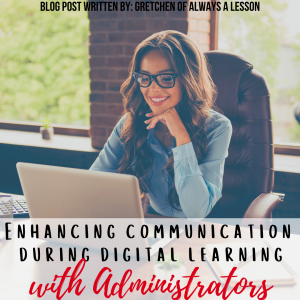Enhancing Communication during Digital Learning with Administration
Communication during digital learning can be an obstacle, but not an insurmountable one.
This series of posts will outline ways to communicate with various stakeholders (parents, colleagues, and students) during digital learning as well as share what type of information to communicate.
Although digital learning looks different for everyone right now during Covid-19 shutdowns, the truth is no one is exempt from digital learning in some form or fashion. Distance learning is here to stay for the foreseeable future which means we better figure out how to make it successful.
Enhancing communication is essential to continue on a path of learning and growth for stakeholders like administration, colleagues, students and parents.
 Enhance Communication with Administration
Enhance Communication with Administration
-
- Share what you are doing– Administration wants to know how things are going in the classroom and that includes strategies you are utilizing. They can’t be in every teacher’s virtual classroom so they’re counting on you to keep them up-to-date. For example, you might share a new tool you’re utilizing, teacher strategy you’re implementing, an upcoming project, or toot your own horn with achievements!
- Ask for additional learning opportunities– Online teaching and learning is new for many of us. Search for online PD’s or mentorship opportunities to grow your skillset. Then, advocate to your administrators for funding or support.
- Seek feedback on your teaching– Many times, feedback teachers receive is on lesson plans or a quick snap shot observation. However, if there are specific aspects of your instruction where you want feedback, ask! For example, you might ask administration to review your feedback to students, morning meeting routine or maybe an engagement strategy during direct instruction.
- Provide an update on student performance– There are certain data points administrators can access on their end (ie. assessments via online portal), but there are other data points essential to student learning that only a teacher can share. For example, whole group data points like the percentage of students logging in or turning in assignments or individual data points like change in achievement levels or engagement could be helpful information to share.
- Keep them in the loop on high level hiccups– There are bound to be obstacles during virtual learning. If there are incidents that require the administrators to be notified then do it before they escalate and share updates often. For example, any parent complaints, excessive student absences or major declines in performance levels. This helps administration support you and provide direction on best next steps.
Consistent, on-going communicating with stakeholders during remote learning is of utmost importance to make the school year successful for all. Using communication tools like Google Meet, Skype, Zoom and FaceTime are great for connecting face-to-face in a virtual world. Using Voxer, email, and text are helpful to staying connected on a daily basis through voice or print.
Whatever tool or strategy you employ, enhancing communication during remote learning is the goal to success for everyone involved.
How are you communicating with administrators during remote learning?


 Get Edu-Tips, Freebies and grab your FREE Study Guide for Gretchen’s New Book!
Get Edu-Tips, Freebies and grab your FREE Study Guide for Gretchen’s New Book!